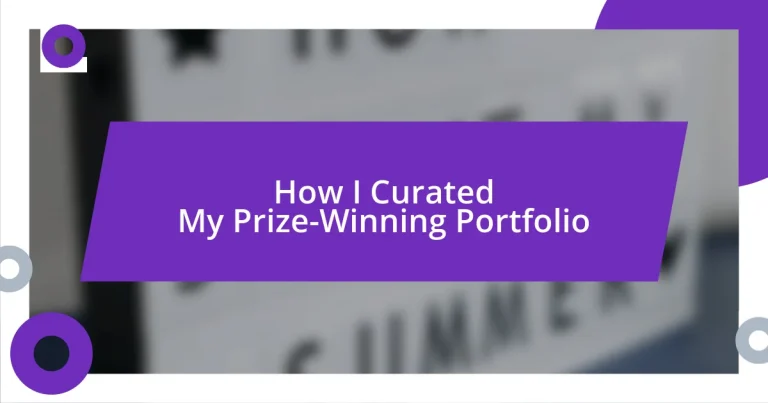Key takeaways:
- Portfolio curation is about creating a cohesive narrative that reflects both personal growth and artistic identity, focusing on quality over quantity.
- Identifying unique style involves reflecting on influences, experimenting with techniques, and gathering feedback, which collectively shape one’s artistic evolution.
- Effectively presenting and sharing a portfolio online, while gathering feedback, enhances engagement and opens up opportunities for connection and growth.

Understanding Portfolio Curation
Portfolio curation is much like storytelling; it’s about weaving together a narrative that showcases my growth and creativity. I remember the time I looked over my work and realized that each piece not only represented a skill but also a phase of my personal journey. Have you ever considered how your experiences shape what you present?
When I was selecting pieces for my portfolio, I focused on quality over quantity. There were moments when I had to let go of projects I loved but didn’t quite fit the narrative I wanted to portray. It’s hard, isn’t it? But truly understanding your vision is key to creating a cohesive body of work that resonates.
In my experience, aligning my portfolio with my aspirations has been a game-changer. Each piece is intentionally chosen to reflect not just what I can do, but who I am as a creator. This clarity has sparked conversations with viewers that I never expected. Have you found that your portfolio can open doors and create connections in ways you didn’t foresee?

Identifying Your Unique Style
Identifying your unique style is a deeply personal journey. I still vividly recall the moment when a mentor pointed out that my work reflected a blend of vivid colors and intricate patterns, traits that illuminated my passion for liveliness and storytelling. An intentional examination of my pieces revealed recurring themes—topics and techniques that excited me. That realization was a turning point.
To truly discover your distinct style, consider these key aspects:
- Reflect on your influences: Who inspires you? Analyzing their impact can help pinpoint what resonates within your own work.
- Experiment boldly: Don’t shy away from trying new techniques or subjects. This exploration may lead you to unexpected gems that feel uniquely you.
- Gather feedback: Engage friends, colleagues, or mentors to discuss your work. Their perspectives can illuminate nuances you hadn’t considered before.
- Document your evolution: Keep a visual diary of your projects. Over time, patterns will emerge, revealing your stylistic preferences.
Finding my own style involved countless experiments, some of which I’d consider missteps. Yet, those missteps became invaluable lessons, shaping not just my art but also my identity as a creator. Embracing this process has made it all the more exciting to see how my work evolves with me.

Selecting Your Best Work
When it came to selecting my best work, I learned to smile at the challenge of narrowing it down. I began by creating a shortlist of pieces that sparked joy or strong memories. For example, I still remember the electrifying feeling I had when completing a piece that won me my first exhibition spot; it immediately became a candidate. I found that tapping into the emotions behind each work helped me determine their significance in my journey.
As I sifted through my portfolio, I put each piece under the microscope, asking, “Does this piece tell a story?” One specific project that stood out was an experimental piece I created during a particularly tumultuous time in my life. It resonated with viewers not only for its aesthetic but also for its emotional depth. I realized that work that spoke to the viewer tended to resonate even more with my evolving narrative.
In my mind, a well-curated portfolio is like a conversation starter. As you select your best work, consider how each piece contributes to this dialogue. Think of your audience—what do you want them to take away from your collection? I remember the awe in the eyes of those who experienced my work for the first time; that reaction emphasized the importance of choosing pieces that provoke thought or emotion.
| Selection Criteria | Personal Reflection |
|---|---|
| Emotional resonance | Projects that evoke strong feelings or memories stand out. |
| Storytelling ability | Pieces that narrate a journey connect deeply with viewers. |

Organizing Your Portfolio Effectively
Organizing your portfolio effectively is about creating a narrative that flows seamlessly. When I first arranged mine, I remember experimenting with different layouts and orderings. I found that grouping works by themes—not just by technique or medium—helped to create a cohesive story that my audience could easily follow. It’s like walking through an art gallery; you want each piece to not only shine on its own but also contribute to the overall experience.
As I organized my pieces, I asked myself, “What do I want the viewer to feel?” For instance, I once placed a series of vibrant landscapes followed by more subdued portraits. This contrast evoked curiosity and deep emotion, guiding the viewer through my artistic journey. I learned that the transitional elements—like color schemes or emotional tones—played a significant role in directing that narrative.
I also discovered the importance of context. Adding descriptions alongside my work allowed me to explain my inspiration and process directly. It was fascinating to see how viewers connected more deeply when they understood the background story. Have you ever had an artwork move you more when you learned its backstory? That’s why I made sure to include insights into my creative process; it turned my portfolio into a conversation rather than just a display of artworks.

Presenting Your Work Professionally
Presenting your work professionally can truly elevate its impact. When I first showcased my portfolio, I invested time in quality presentation. I remember using a crisp, clean layout with high-resolution images, ensuring that each piece was framed by a subtle border to draw the viewer’s eye. Attention to detail matters; have you ever felt compelled to explore an artwork simply because it was beautifully displayed? That initial impression can set the stage for an entire experience.
Each piece in my portfolio was accompanied by thoughtful captions, revealing insights into my creative thought process. I’ll never forget the moment a viewer paused, scanning the descriptions, and then looked up, visibly moved. It struck me just how crucial it was to share the narrative behind each work. This connection not only offers clarity but also invites engagement—after all, how often do we want to know the ‘why’ behind what we see?
In addition, I made sure to use high-quality materials for any physical presentation. I recall the pride I felt presenting my work in a well-printed booklet. It felt more than just a collection; it was a tangible representation of my journey. Think of this as a first handshake—your portfolio should exude professionalism from the very start, leaving a lasting impression that entices viewers to delve deeper into your artistic world.

Sharing Your Portfolio Online
Sharing your portfolio online can open up a world of opportunities and connections. I still remember the thrill of my first online portfolio launch; the excitement was palpable. Choosing the right platform was crucial for me. I was drawn to visually-oriented sites that not only showcased my work but also allowed me to express my artistic identity. Have you ever felt that rush of sharing your creations with the world? That sensation fueled my motivation to keep refining my digital presence.
I learned early on that social media plays an important role in sharing my portfolio. I’ll never forget the spike in engagement I experienced when I started posting behind-the-scenes content, like my work in progress or glimpses into my creative process. This intimate look made my work resonate with viewers beyond just the final piece. It’s funny how sharing a simple sketch or brainstorming session can create a dialogue that draws people in. I found that the more authentic I was, the greater the connection I fostered with my audience.
Another key takeaway for me was the importance of consistency. Regularly updating my portfolio helped keep my audience engaged and reminded them of my evolving journey. I still remember an instance where a fellow artist reached out, expressing admiration for a particular series I posted intermittently. It reinforced the idea that persistence pays off. How do you keep your portfolio fresh? By sharing not just your completed works but also your growth, you invite others to be part of your artistic evolution.

Gathering Feedback for Improvement
Feedback is one of the most invaluable tools in refining my portfolio. I remember a pivotal moment when a mentor provided critique on a series I had passionately created. Initially, I felt defensive, but as I listened, I realized his suggestions could unlock new levels in my work. Have you had that eye-opening interaction where feedback turned your perspective upside down? It’s in those moments that lasting growth occurs.
In my experience, I’ve found creating a feedback loop with trusted peers can dramatically enhance the quality of my portfolio. I often host informal sessions where friends and fellow artists critique each other’s work. Not only does this foster community, but it opens avenues for discussions I never anticipated. I can recall one session where a simple comment about color usage led me to experiment with palettes I hadn’t considered before. How might collaboration push your creativity? I assure you, opening your work to diverse opinions can spark inspiration you didn’t know you were missing.
Lastly, I’ve learned the importance of distilling feedback into actionable steps. After receiving critiques, I often jot down the insights that resonate most with me. I still vividly remember the time I compiled feedback from multiple sources and noticed a pattern emerging about my narrative style. That clarity helped me reevaluate my approach, making my portfolio not just a collection of art, but a cohesive story of my journey. What insights could you uncover with a structured reflection on feedback? Embracing this process allows me to continually improve and present my best self in my work.














